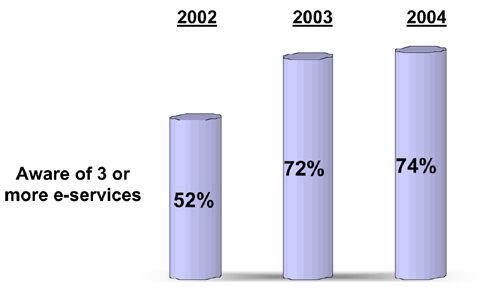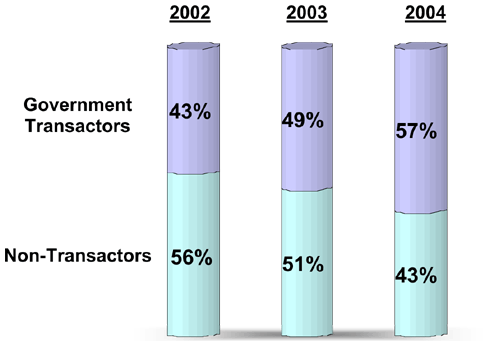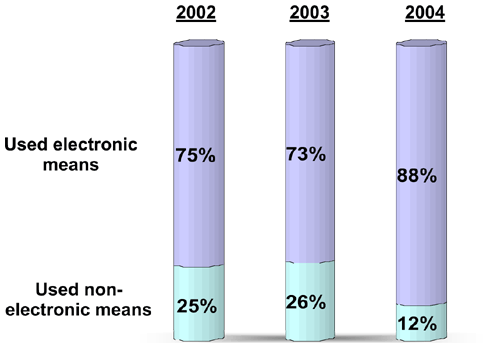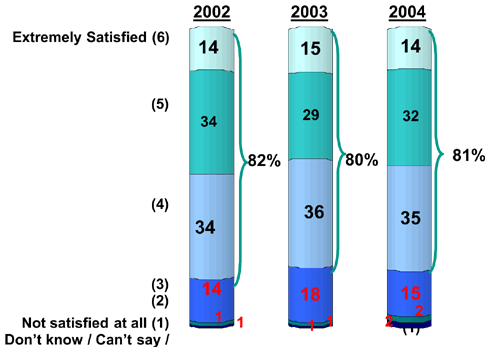Annual eGovernment Customer Perception Survey Conducted in 2005
1. Background and Methodology
The e-Government Customer Perception Survey is an annual exercise that is conducted to assess the public's levels of receptivity toward e-Government initiatives. This is the third e-Government Survey commissioned by the Managing for Excellence Directorate, Ministry of Finance and managed by the Infocomm Development Authority of Singapore.
The objectives of the survey are to:
- Determine awareness of Government e-Services;
- Determine the proportion of population who have transacted with the Government electronically and their satisfaction with Government e-Services; and to
- Determine the proportion of population who have transacted with the Government using non-electronic means (e.g. counter, post, fax) and their reasons for not using the electronic means.
1,204 respondents, representative of the total demographic population above the age of 15 were surveyed between Jan. 26, 2005 to Feb. 2, 2005. Data collection was done using phone interviews, administered in English, Chinese or Malay.
2. Survey Results
(i) In 2004, 74% Of The Population Have Read Or Heard Of At Least 3 Government Services
The 2004 survey shows that three-quarters or 74% of the population are aware of at least three government e-services compared to 72% in 2003 and 52% in 2002.

(ii) The 5 Most Cited Governement Electronic Services in 2004
Of the government e-services they have read or heard of, the five most cited e-services in 2004 were:
- File Income Tax (IRAS)
- Request for CPF Statements (CPF Board)
- Top-up or Encash Economic Restructuring Shares (CPF Board)
- Airline or Flight Information (CAAS)
- Pay Parking Fines (URA & HDB)
(iii) In 2004, 57% Of The Population Transacted With The Government
In 2004, the proportion of population who transacted with the government was 57%, compared with 49% in 2003 and 43% in 2002.

(iv) In 2004, 88% Of The Government Transactors Used Electronic Means At Least Once in the Past 12 Months
Of those who have a need to transact with the government, 88% used electronic means (i.e. the internet, kiosk, IVRS, e-mail, SMS, etc.) at least once in the past 12 months. This is an improvement, compared with 73% in 2003 and 75% in 2002. The other 12% used non-electronic means such as counter, fax or post to transact with the government.

(v) Profile Of Government Transactors Who Use Electronic Means To Transact With The Government
The typical profile of government transactors who use electronic means to transact with the government are:
- between 30-39 years old.
- hold white-collar jobs.
(vi) Reasons Why People Do Not Use Electronic Means to Transact With the Government
In the 2004 survey, of the group who had a need to transact with the government, 12% of the government transactors did not use electronic means to obtain information or transact with the government. The main reasons given were:
- No need to use government electronic services
- Prefer personal contact
(vii) Profile Of Government Transactor Who Use Non-Electronic Means To Obtain Infomation/Transact With The Government
The typical profile of government transactors who used non-electronic means to transact with the government are:
- aged 50 and above.
- likely holding blue-collar jobs, are housewives, retired or unemployed.
(viii) IN 2004, 81% Of The Users Were Satisfied With The Overall Quality Of The E-Services
Generally, government transactors who used electronic means to transact with the government were satisfied with the overall quality of e-services. In 2004, 81% gave 4 and above out of a 6-point scale. In 2003, the result was 80% while in 2002, the result was 82% for the overall quality of e-services.

If "don't know/ can't say" is excluded, percent satisfied (i.e. 4-6) is 82% for 2002, 80% for 2003, 81% for 2004


.webp)